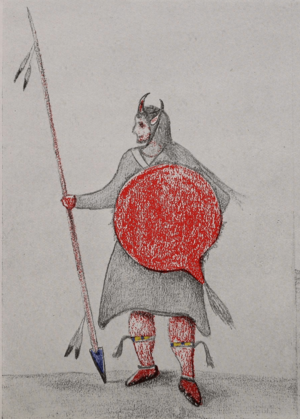Cheyenne military societies facts for kids
The Cheyenne military societies were very important groups in the traditional Cheyenne Native American tribe. They worked alongside the Council of Forty-four, which was another main part of the tribe's government. While the council chiefs managed the tribe's overall rules, the leaders of the military societies had different jobs. They helped keep order, managed tribal hunts, and led the warriors in battle. In the past, the council chiefs chose which of the six military societies would take on these duties. After a while, they would pick a different society to serve.
Contents
Cheyenne Warrior Societies: The First Four
The Cheyenne people tell stories about a wise leader named Sweet Medicine. He is said to have created the first four Cheyenne warrior societies. Each society had its own special songs and was led by a head man. Over many years, some of these societies changed or formed new groups.
Fox Warriors: Quick and Clever
The Fox Warriors Society was also known as Swift Fox or Kitfox. You could find this society among both the Northern and Southern Cheyenne tribes. Two other groups, the Coyote Warriors Society and the Flintmen Society, grew out of the Fox Warriors. Among the Northern Cheyenne, the Kit Fox Soldiers often felt they were the most important. They also had strong family ties through marriage with the Lakota Sioux's Kit Fox Society.
Elk Warriors: Strong and Brave
The Elk Warriors Society had many names, like Elk Horn Scrapers or Medicine Lance. This society was active in both the Northern and Southern Cheyenne tribes. Famous warriors like Roman Nose and George Bent, who was part Cheyenne, belonged to this group.
Shield Warriors: Protectors of the People
The Shield Warriors Society was also called Red Shield. This society was originally found in both the Northern and Southern Cheyenne tribes. Today, it mostly exists among the Northern Cheyenne. The Buffalo Warriors group, also known as Buffalo Bull, was a part of the Shield Warriors Society.
Bowstring Men: Skilled and Focused
The Bowstring Men were also known as the Owl Man's Bowstring. This is because a Cheyenne warrior named Owl Man started the group. This society was once found in both the Northern and Southern Cheyenne tribes. Today, it is mainly among the Southern Cheyenne, where it is also called the Wolf Warriors Society. The Crazy Dog Society developed from the Bowstring Men in the 1800s. This happened after a vision given to a warrior called Owl Friend. Among the Northern Cheyenne, the Wolf Warriors slowly started to be called Crazy Dogs. Both the Wolf Warriors (Southern Cheyenne) and the Crazy Dogs (Northern Cheyenne) saw themselves as part of the original Bowstring Men. In the Northern Cheyenne tribe, both the Crazy Dogs and the Bowstrings (or Wolf Warriors) exist as separate groups.
The Fifth Society: Dog Warriors
The Dog Warrior Society was also known as Dog Men. White settlers sometimes called them Dog Soldiers. This society was formed after a special dream, following the time of the prophet Sweet Medicine. It was originally found in both the Northern and Southern Cheyenne tribes. Today, it is mainly among the Southern Cheyenne.
The Crazy Dogs were also called Foolish Dogs. This group was similar to the Bowstring Men in what they did. However, they were only found among the Northern Cheyenne. In the Northern Cheyenne tribe, the Dog Warrior Society and the Wolf Warriors joined together. This led to the creation of the new Dog Warriors, now known as the Crazy Dogs. Many people think the Crazy Dogs are a sixth society, not just a branch of the fifth. Members of this society were known for their amazing endurance and cleverness, like coyotes. They were excellent runners and good at games.
The Sixth Society: Contrary Warriors
The Contrary Warriors Society was also known as the Inverted Bow-string Society. Members of this group showed their bravery by riding backward into battle.
The Contrary Society was also called the Clown Society. This group used similar spiritual powers as the Contrary Warriors Society. It was mostly made up of older Cheyenne members. They were responsible for teaching the Cheyenne people about their traditions and rules. They did this in a funny way, using humor and jokes, often by acting opposite to how things were usually done.
Warrior Women's Society: Brave Women
Ehyophsta was a brave woman who fought in the Battle of Beecher Island. She was part of a society of women who went to war. It was once thought that these women only fought if their husbands were also warriors. However, we now know that women like Mochi were warriors on their own. Mochi had her own war pony and special war medicine, and she was also a member of this society.


